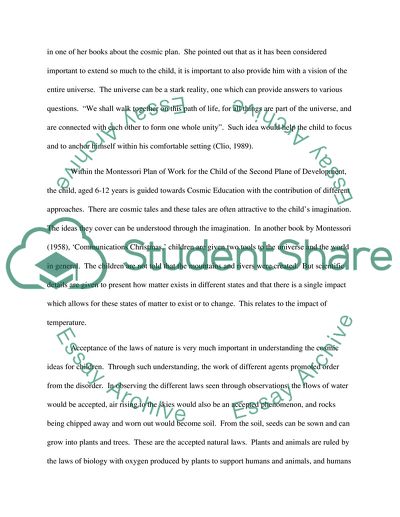Cite this document
(“Examine how Montessori's understanding of the concept of the Cosmic Essay”, n.d.)
Examine how Montessori's understanding of the concept of the Cosmic Essay. Retrieved from https://studentshare.org/education/1656411-examine-how-montessoris-understanding-of-the-concept-of-the-cosmic-plan-underpins-the-organisation-and-implementation-of-her-cosmic-approach-to-educationdesigned-to-meet-the-needs-of-the-primary-age-range
Examine how Montessori's understanding of the concept of the Cosmic Essay. Retrieved from https://studentshare.org/education/1656411-examine-how-montessoris-understanding-of-the-concept-of-the-cosmic-plan-underpins-the-organisation-and-implementation-of-her-cosmic-approach-to-educationdesigned-to-meet-the-needs-of-the-primary-age-range
(Examine How Montessori'S Understanding of the Concept of the Cosmic Essay)
Examine How Montessori'S Understanding of the Concept of the Cosmic Essay. https://studentshare.org/education/1656411-examine-how-montessoris-understanding-of-the-concept-of-the-cosmic-plan-underpins-the-organisation-and-implementation-of-her-cosmic-approach-to-educationdesigned-to-meet-the-needs-of-the-primary-age-range.
Examine How Montessori'S Understanding of the Concept of the Cosmic Essay. https://studentshare.org/education/1656411-examine-how-montessoris-understanding-of-the-concept-of-the-cosmic-plan-underpins-the-organisation-and-implementation-of-her-cosmic-approach-to-educationdesigned-to-meet-the-needs-of-the-primary-age-range.
“Examine How Montessori'S Understanding of the Concept of the Cosmic Essay”, n.d. https://studentshare.org/education/1656411-examine-how-montessoris-understanding-of-the-concept-of-the-cosmic-plan-underpins-the-organisation-and-implementation-of-her-cosmic-approach-to-educationdesigned-to-meet-the-needs-of-the-primary-age-range.


